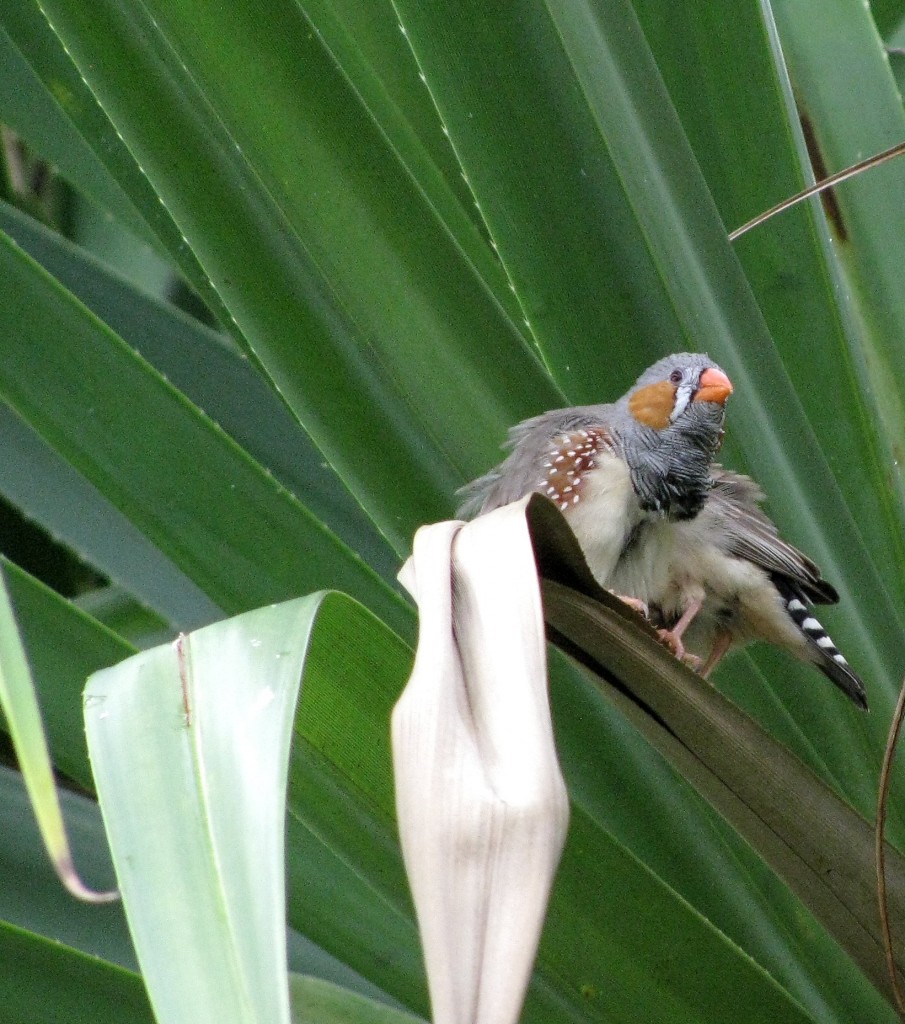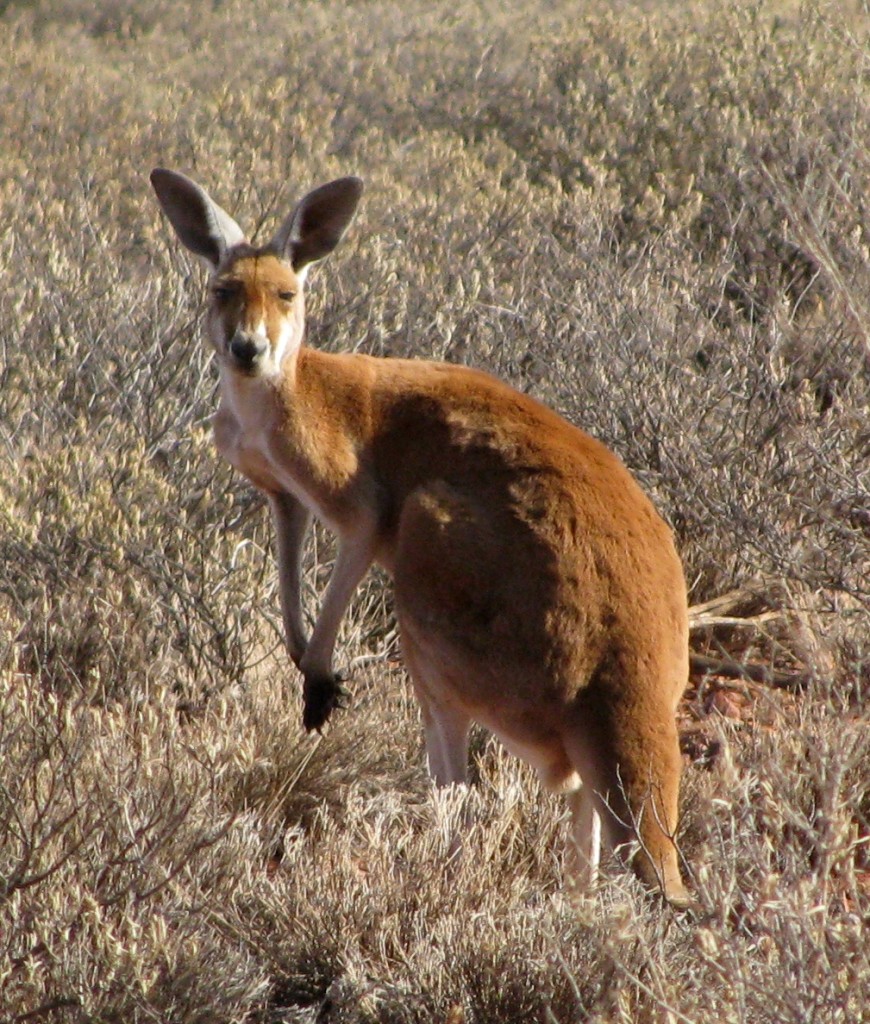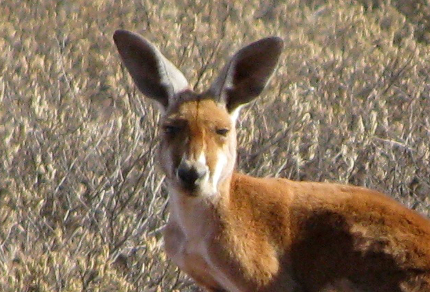
Lake Fairfield (© Magi Nams)
Autumn darkness lifted into a late dawn muted by gentle rain. Wanting to explore with my camera, I worked indoors until mid-morning, and then, when the rain became sporadic drizzle, cycled into unknown territory in Idalia, following Fairfield Waters Drive to Lakeland Boulevard. This led me to a path bordering Lake Fairfield, an artificial wetland that was constructed as part of the Fairfield Waters development, but which is nonetheless linked ecologically with the Ross River. Until today, I hadn’t known it existed, and my first thought was that the lake and its bordering lawns and plantings of trees, shrubs, and perennial flowers looked so new, so manicured, and very artificial. Yet, that thought was quickly replaced by the realization that the wetland, even in its present young stage, attracted an impressive suite of birds.

Zebra Finches (© Magi Nams)
Flocks of zebra finches chittered in shaggy pandanus palms bearing huge cone-like fruits. While the small, colourful seed-eaters preened their rain-ruffled plumages, blue-faced honeyeaters, magpie-larks, and masked lapwings foraged and voiced their calls nearby. I heard begging calls issuing from a young tree and spotted an untidy brown and white juvenile bird perched on a branch. My sudden interest in it caused a pair of magpie-larks to create a fuss and fly into the tree, thereby identifying the young bird as an immature magpie-lark. Attracted by the commotion, two honeyeaters and a couple of mynas darted into the tree, only to be routed from it by the parent magpie-larks.
As I cycled farther along the lakeside, a black-faced cuckoo-shrike flew across the wetland, and a broad-winged Australian pelican glided above the water’s surface with surprising grace before sweeping its wings up to brake into a controlled landing on the far shore. At the north end of the lake, a flock of magpie geese stood expectantly on the lawns, while white ibises and a little egret foraged in a nearby muddy ditch, accompanied by the first black-fronted dotterel I’d seen – a small, vividly-marked shorebird with a brilliant red beak and black bands around its head and across its chest. My one thought on cycling away from the lake was a modified quote from the movie Field of Dreams: If you build it, they will come.

Red Kangaroo (© Vilis Nams)
Later in the day, I cooked kangaroo kebabs for supper. Last week, Vilis had said that he wanted to try eating kangaroo, so I pointed out the roo meat at Coles on Saturday, and he chose a packet of kebabs flavoured with garlic and herbs. Following the cooking instructions on the packet, I seared the kebabs in a hot pan, and then reduced the heat and continued frying them until done to our taste. Wondering if the meat would be tough and stringy, I bit into it hesitantly; however, it was tender and fine-grained. The flavour was distinctly different from that of beef or pork, but not strongly ‘wild’ and certainly not objectionable.
In mainland Australia, commercial hunters licensed by the government are allowed to harvest five of the larger species of macropods (red, eastern grey, and western grey kangaroos plus common wallaroos and whiptail wallabies), and in Tasmania, two smaller macropod species (red-necked wallabies and rufous-bellied pademelons).1 Most of the harvested meat (70%) is exported to European markets, although it was sanctioned for human consumption throughout Australia in 1993.2 Some is used to make dog food, and the skins are processed into leather or tanned hides. 2,3 All of the meat is harvested from wild animals, with the vast majority of it taken from free-ranging populations living on privately-owned, arid rangelands.2 Harvest quotas are determined by aerial population surveys conducted in each state by National Parks Authorities, and are generally set at 15-20% of population numbers.3
Not surprisingly, the harvest of kangaroo meat has sparked controversy, with wildlife activists facing off against the industry.1 However, the harvest is apparently supported by numerous Australian ecologists,2 on the premise that it’s a way of obtaining a sustainable amount of high-quality protein from Australia’s fragile arid grasslands while reducing the overall grazing pressure on the environment caused by increasing population numbers of some kangaroo species.3 It’s a striking irony that Australian wildlife managers are charged with the responsibility of setting quotas for the culling of particular macropod species, while at the same time establishing policies to protect other, highly vulnerable macropods from extinction.
References:
1. Australian Government, Department of the Environment, Water, Heritage and the Arts. Commercial harvesting of Kangaroos in Australia. Updated 19-Feb-2007. Accessed 9-Jun-2010. http://www.environment.gov.au/biodiversity/trade-use/wild-harvest/kangaroo/harvesting/roobg-01.html
2. Wikipedia. Kangaroo Meat. Updated 15-Mar-2010. Accessed 20-Apr-2010. http://en.wikipedia.org/wiki/Kangaroo_meat
3. John Kelly. Kangaroo Industry Association of Australia. 2008. Accessed 20-Apr-2010. http://www.kangaroo-industry.asn.au/industry.html


